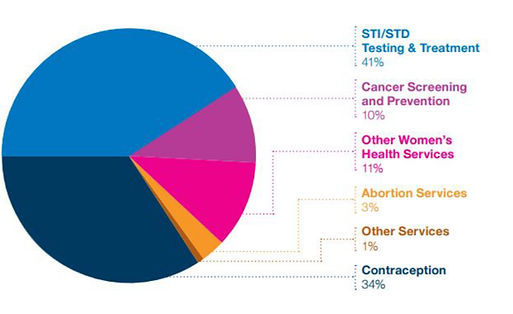

Objective: To change the current perception of the brand from an abortion factory to a vital institution in women's health. One that provides a variety of healthcare services to low income youth. To make people feel comfortable sending their sons and daughters to one of their clinics.

Target Demographic:
-
Men
-
Ages 45-65
-
Lower - Middle Class
-
Living in Rural and Suburban areas
-
Regions such as the Bible Belt, the Great Plains, Appalachia, parts of the Midwest.
-
-
Fundamentalist Christians
-
Prefer abstinence-only education
-
Believe life begins at conception
Strategy:
To change perceptions by busting the myths people have about the organization which make them so opposed to our organization. Additionally, use an emotional appeal by talking about the importance of these services are for the women in their lives, particularly their daughters. We’re not trying to make them Pro-Choice, we’re just trying to make them pro-Planned Parenthood.

Myths:
1. Birth control pills are only used to prevent pregnancy (which some see as an early form of abortion).
2. Planned Parenthood's services are paid for by the government, i.e. tax payers.
3. Planned Parenthood does abortions more than anything else.
Truth:
-
Birth control pills have many important uses regarding women’s health besides preventing pregnancy.
-
Abortion services haven’t been government funded in decades.
-
Abortion only accounts for about 3% of services provided by Planned Parenthood.
PRIMARY RESEARCH
Interview with
Vernita Gutierrez (Fmr. Marketing Manager)
Director of Community Engagement at Planned Parenthood Pacific Southwest
-
What are your responsibilities as a marketer for PP? What do you do?
Partnerships. Communicating with others for marketing strategy and then working with vendors for placement.
2. What is your greatest challenge in marketing for PP?
Getting the community to understand all that we do. Basically informing the public about the wide array of services offered by PP. So many have a limited view of what they actually provide.
3. Do you focus more on reaching the market that is likely to use your services or on changing the minds of those who are in opposition to your organization?
Both. The main focus is on reaching consumers, but also in raising awareness. We don’t waste time trying to reach those whose minds we know we’ll never change. Focus more on reaching potential users.
4. What is your greatest obstacle as far as social perception of PP and how do you deal with that?
People tend to think of two major things when they hear “Planned Parenthood:” Birth control first and then abortion. The greatest obstacle is to change that first impression and get people to understand that that’s not all we do. We deal with it by reestablishing our message and, more recently by doing coalition work for other social justice issues such as immigration, LGBT rights, the wage gap, etc. Intersectionality.
5. Have you ever made any materials designed specifically to persuade those in government, or do you focus more on consumer advocacy to influence legislation?
Focus on consumer advocacy and public awareness. PP action fund does the more politically minded campaigning. Lobbying is a form of marketing towards the government. Legal briefs for proposed legislation would be the materials.
6. What have you found to be the best way to dispense knowledge to the public, besides the website? For example, facts about birth control?
Varies based on region. Bus ads, billboards, and social media are the main mediums currently used. Educational presentations at schools and tabling at festivals and other community events are big as well.
7. When a PR crisis comes up like the “baby parts” video hoax and other misconceptions about the organization, how do you deal with that? What is the best way to assure the public?
Let people know that people’s safety is paramount. Enforce their values and assure the public that all actions are legal. Legality is taken very seriously.
8. What have you been doing to combat the opposition from the Trump administration to reproductive rights and women’s equity in general?
Remain focused on providing services. Educate people on the negative impact of this legislation. Keep people’s attention, encourage people to speak up.
9. What is your focus now and going forward in marketing for PP? What do you want the consumer to know or do? What problems are you trying to solve?
In California, addressing the chlamydia and gonorrhea epidemic through evidence-based sex ed. About half of all pregnancies are unintended. Also, long term birth control methods, positioning ourselves as experts on birth control. Speaking with women about their life plans during consultations to help them find the best options.
10. What is the difference between your donor base and your user base and how do you market to each?
Donors are older, former users of PP, and long-time supporters. Reached through letters and advertisements on KPBS. Patients are 18-24 years old. Marketing emphasizes affordability and confidentiality. Mostly done through social media.
TV SPOT PROPOSAL
A woman calls her father to tell him she has cervical cancer. She’s going to Planned Parenthood. They have given her birth control pills as part of her treatment.
This accomplishes several things:
-
Tells people about one of the lesser known services that PP provides
-
Raises awareness to a lesser known use for birth control
-
Creates an emotional appeal
-
Talks about PP without mentioning abortion or sex, making sensitive audiences more comfortable.